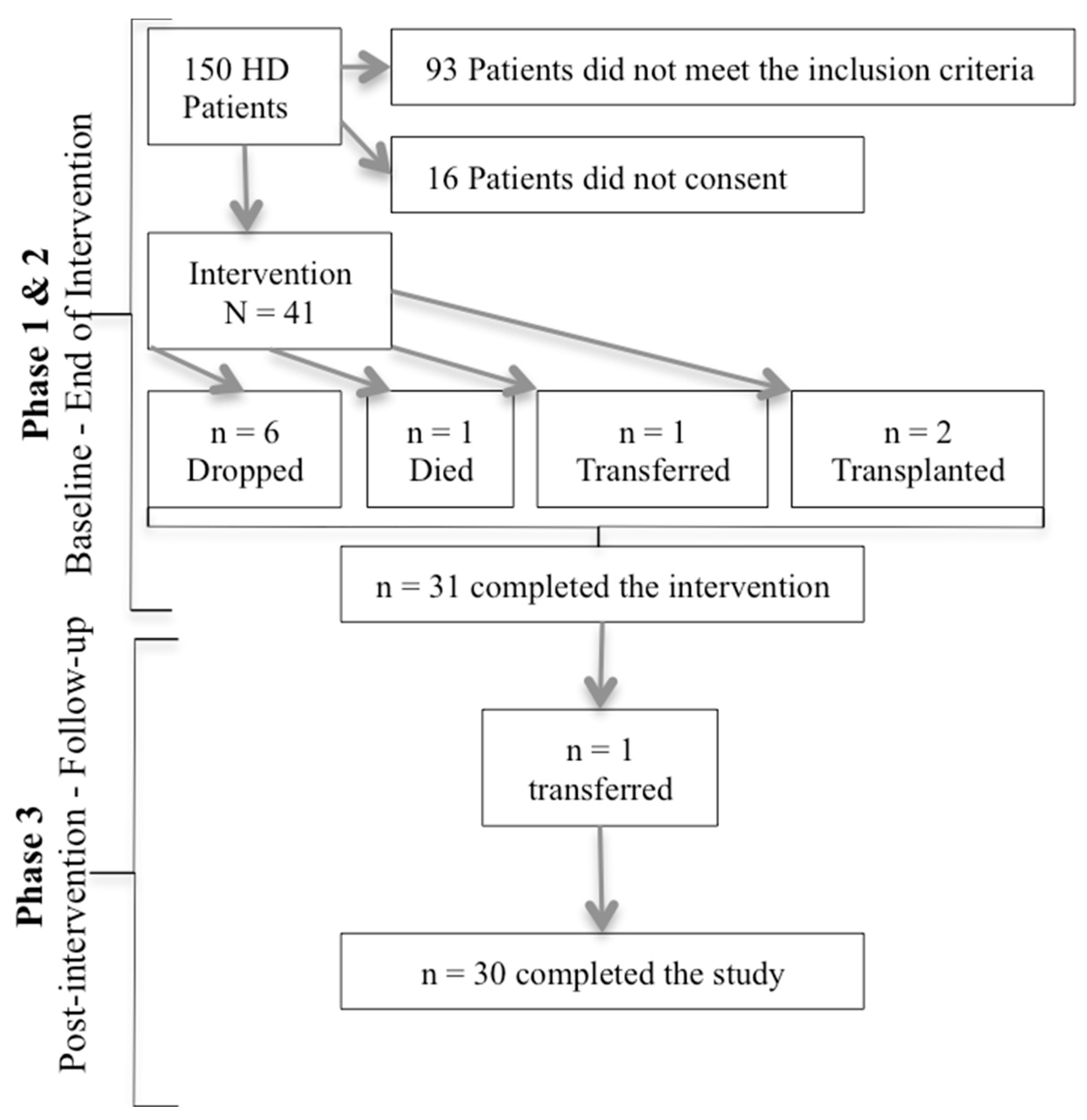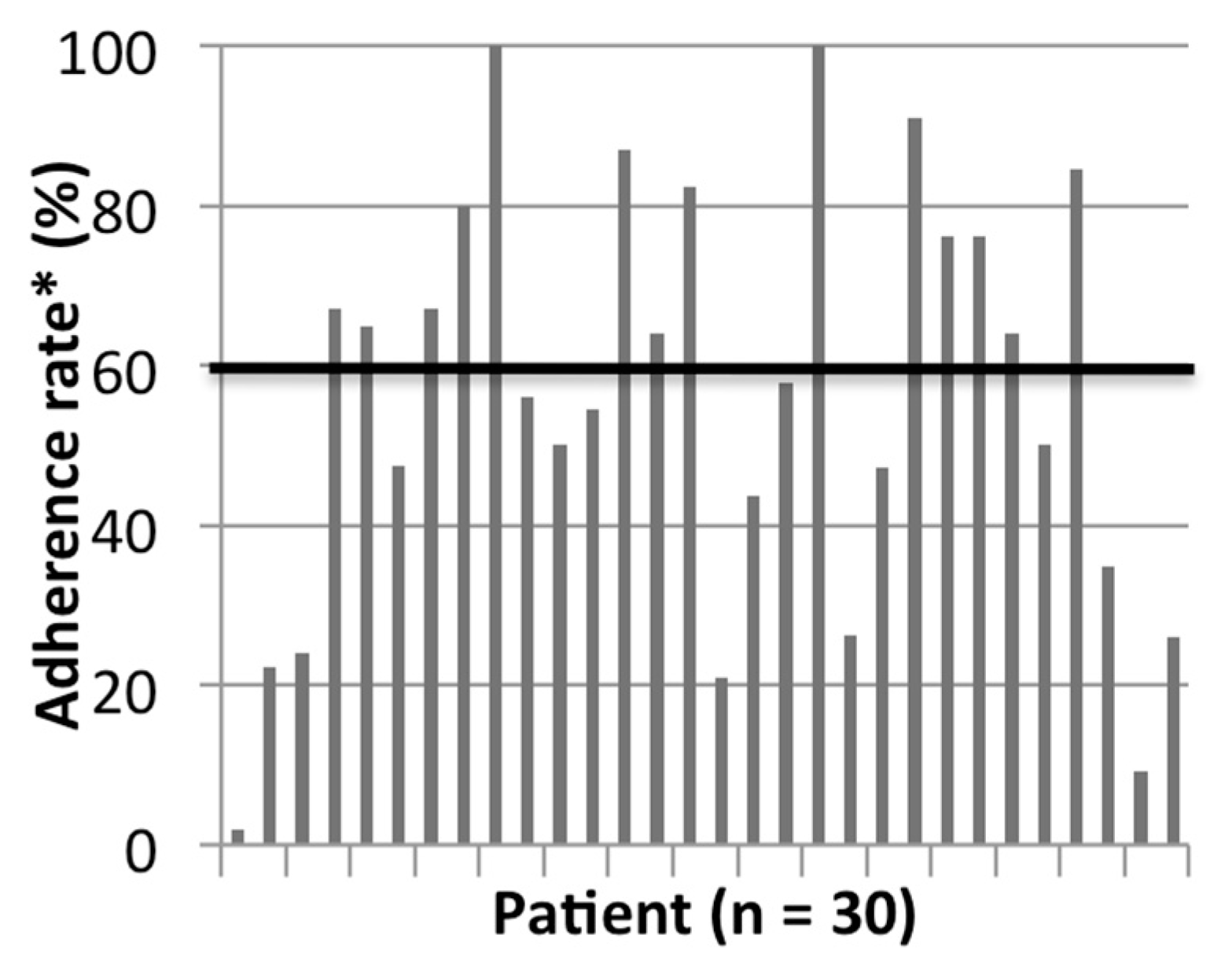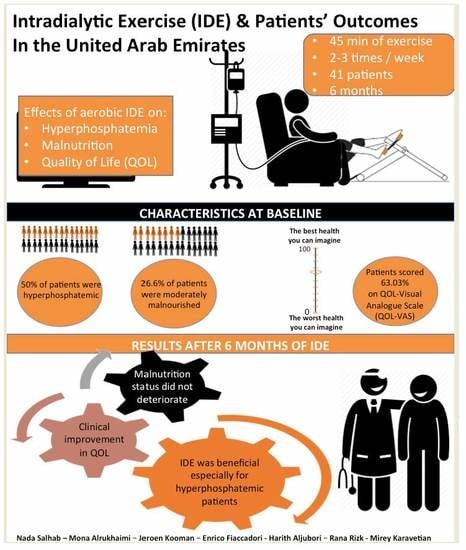Effect of Intradialytic Exercise on Hyperphosphatemia and Malnutrition
Abstract
:1. Introduction
2. Materials and Methods
2.1. Study Design and Participants
2.2. Study Protocol
2.3. Outcome Measures
2.4. Data Collection
2.5. Sample Size
2.6. Statistical Analysis
3. Results
3.1. Characteristics of Patients Who Completed the Study
3.2. Aerobic Exercise
3.3. Clinical and Laboratory Parameters of Included Patients
3.4. Outcome of Patients Who Were Hyperphosphatemic at Baseline
3.5. Quality of Life (EQ-5D-5L)
3.6. Adverse Events
4. Discussion
5. Conclusions
Author Contributions
Funding
Acknowledgments
Conflicts of Interest
References
- Amann, K.; Gross, M.L.; London, G.M.; Ritz, E. Hyperphosphataemia—A silent killer of patients with renal failure? Nephrol. Dial. Transp. Off. Publ. Eur. Dial. Transp. Assoc. Eur. R. Assoc. 1999, 14, 2085–2087. [Google Scholar] [CrossRef] [PubMed]
- Young, E.W.; Akiba, T.; Albert, J.M.; McCarthy, J.T.; Kerr, P.G.; Mendelssohn, D.C.; Jadoul, M. Magnitude and impact of abnormal mineral metabolism in hemodialysis patients in the Dialysis Outcomes and Practice Patterns Study (DOPPS). Am. J. Kidney Dis. Off. J. Natl. Kidney Found. 2004, 44 (Suppl. 2), 34–38. [Google Scholar] [CrossRef]
- Chiu, Y.W.; Teitelbaum, I.; Misra, M.; de Leon, E.M.; Adzize, T.; Mehrotra, R. Pill burden, adherence, hyperphosphatemia, and quality of life in maintenance dialysis patients. Clin. J. Am. Soc. Nephrol. CJASN 2009, 4, 1089–1096. [Google Scholar] [CrossRef] [PubMed]
- Ketteler, M.; Block, G.A.; Evenepoel, P.; Fukagawa, M.; Herzog, C.A.; McCann, L.; Moe, S.M.; Shroff, R.; Tonelli, M.A.; Toussaint, N.D.; et al. Executive summary of the 2017 KDIGO Chronic Kidney Disease-Mineral and Bone Disorder (CKD-MBD) Guideline Update: what’s changed and why it matters. Kidney Int. 2017, 92, 26–36. [Google Scholar] [CrossRef]
- Ikizler, T.A. Dietary protein restriction in CKD: The debate continues. Am. J. Kidney Dis. Off. J. Natl. Kidney Found. 2009, 53, 189–191. [Google Scholar] [CrossRef]
- St. Peter, W.L.; Wazny, L.D.; Weinhandl, E.; Cardone, K.E.; Hudson, J.Q. A Review of Phosphate Binders in Chronic Kidney Disease: Incremental Progress or Just Higher Costs? Drugs 2017, 77, 1155–1186. [Google Scholar] [CrossRef]
- White, A.; Odedina, F.; Xiao, H.; Campbell, E.; Segal, R. The Economic Burden of End-Stage Renal Disease with Hyperphosphatemia: A Study of Florida Medicaid. Dis. Manag. Health Outcomes 2006, 14, 99–106. [Google Scholar] [CrossRef]
- Rizk, R.; Hiligsmann, M.; Karavetian, M.; Evers, S.M. Economic evaluations of interventions to manage hyperphosphataemia in adult haemodialysis patients: A systematic review. Nephrology (Carlton, Vic.) 2016, 21, 178–187. [Google Scholar] [CrossRef] [Green Version]
- Pu, J.; Jiang, Z.; Wu, W.; Li, L.; Zhang, L.; Li, Y.; Liu, Q.; Ou, S. Efficacy and safety of intradialytic exercise in haemodialysis patients: A systematic review and meta-analysis. BMJ Open 2019, 9, e020633. [Google Scholar] [CrossRef]
- Salhab, N.; Karavetian, M.; Kooman, J.; Fiaccadori, E.; El Khoury, C.F. Effects of intradialytic aerobic exercise on hemodialysis patients: A systematic review and meta-analysis. J. Nephrol. 2019, 32, 549–566. [Google Scholar] [CrossRef]
- Orcy, R.; Antunes, M.F.; Schiller, T.; Seus, T.; Bohlke, M. Aerobic exercise increases phosphate removal during hemodialysis: A controlled trial. Hemodial. Int. Int. Symp. Home Hemod. 2014, 18, 450–458. [Google Scholar] [CrossRef] [PubMed]
- Musavian, A.S.; Soleimani, A.; Masoudi Alavi, N.; Baseri, A.; Savari, F. Comparing the effects of active and passive intradialytic pedaling exercises on dialysis efficacy, electrolytes, hemoglobin, hematocrit, blood pressure and health-related quality of life. Nurs. Midwifery Stud. 2015, 4, e25922. [Google Scholar] [CrossRef] [PubMed]
- Makhlough, A.; Ilali, E.; Mohseni, R.; Shahmohammadi, S. Effect of intradialytic aerobic exercise on serum electrolytes levels in hemodialysis patients. Iran. J. Kidney Dis. 2012, 6, 119–123. [Google Scholar] [PubMed]
- Maheshwari, V.; Samavedham, L.; Rangaiah, G.P. A regional blood flow model for beta2-microglobulin kinetics and for simulating intra-dialytic exercise effect. Ann. Biomed. Eng. 2011, 39, 2879–2890. [Google Scholar] [CrossRef]
- Reboredo Mde, M.; Henrique, D.M.; Faria Rde, S.; Chaoubah, A.; Bastos, M.G.; de Paula, R.B. Exercise training during hemodialysis reduces blood pressure and increases physical functioning and quality of life. Artif. Organs 2010, 34, 586–593. [Google Scholar] [CrossRef]
- Giannaki, C.D.; Sakkas, G.K.; Karatzaferi, C.; Hadjigeorgiou, G.M.; Lavdas, E.; Kyriakides, T.; Koutedakis, Y.; Stefanidis, I. Effect of exercise training and dopamine agonists in patients with uremic restless legs syndrome: A six-month randomized, partially double-blind, placebo-controlled comparative study. BMC Nephrol. 2013, 14, 194. [Google Scholar] [CrossRef]
- Golebiowski, T.; Kusztal, M.; Weyde, W.; Dziubek, W.; Wozniewski, M.; Madziarska, K.; Krajewska, M.; Letachowicz, K.; Strempska, B.; Klinger, M. A program of physical rehabilitation during hemodialysis sessions improves the fitness of dialysis patients. Kidney Blood Press. Res. 2012, 35, 290–296. [Google Scholar] [CrossRef]
- Wu, Y.; He, Q.; Yin, X.; He, Q.; Cao, S.; Ying, G. Effect of individualized exercise during maintenance haemodialysis on exercise capacity and health-related quality of life in patients with Uraemia. J. Int. Med. Res. 2014, 42, 718–727. [Google Scholar] [CrossRef]
- Parsons, T.L.; Toffelmire, E.B.; King-VanVlack, C.E. Exercise training during hemodialysis improves dialysis efficacy and physical performance. Arch. Phys. Med. Rehabil. 2006, 87, 680–687. [Google Scholar] [CrossRef]
- Parker, K.; Zhang, X.; Lewin, A.; MacRae, J.M. The association between intradialytic exercise and hospital usage among hemodialysis patients. Appl. Physiol. Nutr. Metab. (Physiol. Appl. Nutr. Metab.) 2015, 40, 371–378. [Google Scholar] [CrossRef]
- Afshar, R.; Shegarfy, L.; Shavandi, N.; Sanavi, S. Effects of aerobic exercise and resistance training on lipid profiles and inflammation status in patients on maintenance hemodialysis. Indian J. Nephrol. 2010, 20, 185–189. [Google Scholar] [PubMed]
- Giannaki, C.D.; Hadjigeorgiou, G.M.; Karatzaferi, C.; Maridaki, M.D.; Koutedakis, Y.; Founta, P.; Tsianas, N.; Stefanidis, I.; Sakkas, G.K. A single-blind randomized controlled trial to evaluate the effect of 6 months of progressive aerobic exercise training in patients with uraemic restless legs syndrome. Nephrol. Dial. Transp. Off. Publ. Eur. Dial. Transp. Assoc. Eur. R. Assoc. 2013, 28, 2834–2840. [Google Scholar] [CrossRef] [PubMed] [Green Version]
- Sakkas, G.K.; Hadjigeorgiou, G.M.; Karatzaferi, C.; Maridaki, M.D.; Giannaki, C.D.; Mertens, P.R.; Rountas, C.; Vlychou, M.; Liakopoulos, V.; Stefanidis, I. Intradialytic aerobic exercise training ameliorates symptoms of restless legs syndrome and improves functional capacity in patients on hemodialysis: A pilot study. ASAIO J. (Am. Soc. Artif. Intern. Organs: 1992) 2008, 54, 185–190. [Google Scholar] [CrossRef] [PubMed]
- Martinson, M.; Ikizler, T.A.; Morrell, G.; Wei, G.; Almeida, N.; Marcus, R.L.; Filipowicz, R.; Greene, T.H.; Beddhu, S. Associations of body size and body composition with functional ability and quality of life in hemodialysis patients. Clin. J. Am. Soc. Nephrol. CJASN 2014, 9, 1082–1090. [Google Scholar] [CrossRef]
- Regolisti, G.; Maggiore, U.; Sabatino, A.; Gandolfini, I.; Pioli, S.; Torino, C.; Aucella, F.; Cupisti, A.; Pistolesi, V.; Capitanini, A.; et al. Interaction of healthcare staff’s attitude with barriers to physical activity in hemodialysis patients: A quantitative assessment. PLoS ONE 2018, 13, e0196313. [Google Scholar]
- Chung, Y.C.; Yeh, M.L.; Liu, Y.M. Effects of intradialytic exercise on the physical function, depression and quality of life for haemodialysis patients: A systematic review and meta-analysis of randomised controlled trials. J. Clin. Nurs. 2017, 26, 1801–1813. [Google Scholar] [CrossRef]
- Sheng, K.; Zhang, P.; Chen, L.; Cheng, J.; Wu, C.; Chen, J. Intradialytic exercise in hemodialysis patients: A systematic review and meta-analysis. Am. J. Nephrol. 2014, 40, 478–490. [Google Scholar] [CrossRef]
- Salhab, N.; Karavetian, M.; Kooman, J.; Fiaccadori, E. Intradialytic Aerobic Exercise in the United Arab Emirates: A Descriptive Study. Arab J. Nutr. Exerc. 2018, 3, 18–34. [Google Scholar] [CrossRef]
- Kliger, A.S.; Foley, R.N.; Goldfarb, D.S.; Goldstein, S.L.; Johansen, K.; Singh, A.; Szczech, L. KDOQI US commentary on the 2012 KDIGO Clinical Practice Guideline for Anemia in CKD. Am. J. Kidney Dis. Off. J. Natl. Kidney Found. 2013, 62, 849–859. [Google Scholar] [CrossRef]
- Wong, J.; Davis, P.; Patidar, A.; Zhang, Y.; Vilar, E.; Finkelman, M.; Farrington, K. The Effect of Intra-Dialytic Exercise on Inflammation and Blood Endotoxin Levels. Blood Purif. 2017, 44, 51–59. [Google Scholar] [CrossRef]
- Borg, G.A. Psychophysical bases of perceived exertion. Med. Sci. Sports Exerc. 1982, 14, 377–381. [Google Scholar] [CrossRef] [PubMed]
- de Lima, M.C.; Cicotoste Cde, L.; Cardoso Kda, S.; Forgiarini, L.A., Jr.; Monteiro, M.B.; Dias, A.S. Effect of exercise performed during hemodialysis: Strength versus aerobic. R. Fail. 2013, 35, 697–704. [Google Scholar] [CrossRef] [PubMed]
- Anding, K.; Bar, T.; Trojniak-Hennig, J.; Kuchinke, S.; Krause, R.; Rost, J.M.; Halle, M. A structured exercise programme during haemodialysis for patients with chronic kidney disease: Clinical benefit and long-term adherence. BMJ Open 2015, 5, e008709. [Google Scholar] [CrossRef] [PubMed]
- Kalantar-Zadeh, K.; Kopple, J.D.; Humphreys, M.H.; Block, G. Comparing outcome predictability of markers of malnutrition-inflammation complex syndrome in haemodialysis patients. Nephrol. Dial. Transp. Off. Publ. Eur. Dial. Transp. Assoc. Eur. R. Assoc. 2004, 19, 1507–1519. [Google Scholar] [CrossRef] [Green Version]
- EuroQol Group. EuroQol—A new facility for the measurement of health-related quality of life. Health Policy (Amsterdam, Netherlands) 1990, 16, 199–208. [Google Scholar] [CrossRef]
- Haskell, W.L.; Lee, I.M.; Pate, R.R.; Powell, K.E.; Blair, S.N.; Franklin, B.A.; Macera, C.A.; Heath, G.W.; Thompson, P.D.; Bauman, A. Physical activity and public health: Updated recommendation for adults from the American College of Sports Medicine and the American Heart Association. Med. Sci. Sports Exerc. 2007, 39, 1423–1434. [Google Scholar] [CrossRef]
- Chigira, Y.; Oda, T.; Izumi, M.; Yoshimura, T. Effects of exercise therapy during dialysis for elderly patients undergoing maintenance dialysis. J. Phys. Ther. Sci. 2017, 29, 20–23. [Google Scholar] [CrossRef]
- Bae, Y.H.; Lee, S.M.; Jo, J.I. Aerobic training during hemodialysis improves body composition, muscle function, physical performance, and quality of life in chronic kidney disease patients. J. Phys. Ther. Sci. 2015, 27, 1445–1449. [Google Scholar] [CrossRef]
- Bohm, C.; Stewart, K.; Onyskie-Marcus, J.; Esliger, D.; Kriellaars, D.; Rigatto, C. Effects of intradialytic cycling compared with pedometry on physical function in chronic outpatient hemodialysis: A prospective randomized trial. Nephrol. Dial. Transp. Off. Publ. Eur. Dial. Transp. Assoc. Eur. R. Assoc. 2014, 29, 1947–1955. [Google Scholar] [CrossRef]
- Besnier, F.; Laruelle, E.; Genestier, S.; Gie, S.; Vigneau, C.; Carre, F. Effects of exercise training on ergocycle during hemodialysis in patients with end stage renal disease: Relevance of the anaerobic threshold intensity. Nephrol. Ther. 2012, 8, 231–237. [Google Scholar] [CrossRef]
- McMurray, A.; Blazey, L.; Fetherston, C. The effect of intradialytic foot pedal exercise on blood pressure phosphate removal efficiency and health related quality of life in haemodialysis patients. R. Soc. Australas. J. 2008, 4, 38–45. [Google Scholar]
- Garber, C.E.; Blissmer, B.; Deschenes, M.R.; Franklin, B.A.; Lamonte, M.J.; Lee, I.M.; Nieman, D.C.; Swain, D.P. American College of Sports Medicine position stand. Quantity and quality of exercise for developing and maintaining cardiorespiratory, musculoskeletal, and neuromotor fitness in apparently healthy adults: Guidance for prescribing exercise. Med. Sci. Sports Exerc. 2011, 43, 1334–1359. [Google Scholar] [CrossRef] [PubMed]
- Alshamsi, S.; Binsaleh, F.; Hejaili, F.; Karkar, A.; Moussa, D.; Raza, H.; Parbat, P.; Al Suwida, A.; Alobaili, S.; AlSehli, R.; et al. Changes in biochemical, hemodynamic, and dialysis adherence parameters in hemodialysis patients during Ramadan. Hemodial. Int. Int. Symp. Home Hemod. 2016, 20, 270–276. [Google Scholar] [CrossRef] [PubMed]
- Karavetian, M.; Elzein, H.; Rizk, R.; Jibai, R.; de Vries, N. Nutritional education for management of osteodystrophy: Impact on serum phosphorus, quality of life, and malnutrition. Hemodial. Int. Int. Symp. Home Hemod. 2016, 20, 432–440. [Google Scholar] [CrossRef]


| n (%) | |
|---|---|
| Gender, Male | 15 (50) |
| Nationality | |
| Emirati | 5 (16.7) |
| Non-Emirati—Arab | 17 (56.7) |
| Non-Emirati—Other | 8 (26.7) |
| Primary Cause of CKD | |
| Diabetes | 16 (53.3) |
| Hypertension | 9 (30.0) |
| Nephritis | 3 (10.0) |
| Others | 2 (6.7) |
| HD Initiation | |
| <1 year | 8 (26.7) |
| 1–4 years | 11 (36.7) |
| >4 years | 11 (36.7) |
| Comorbidities † | |
| Diabetes | 16 (53.3) |
| Hypertension | 28 (93.3) |
| Cardiovascular disease | 4 (13.3) |
| Others | 8 (26.7) |
| Phosphorus ≥5.5 mg/dL | 15 (50) ‡ |
| Mean ± SD | |
| Age (years) | 48.87 ± 11.29 |
| Weight (Kg) | 66.76 ± 17.59 |
| BMI (Kg/m2) | 25.25 ± 6.71 |
| Mean ± SD Baseline | Mean ± SD Post Intervention | Mean ± SD Follow-Up | p-Value/ % Δ | |
|---|---|---|---|---|
| P (mg/dL) | 5.78 ± 1.81 | 5.53 ± 2.14 | 5.52 ± 1.58 | 0.56/−4.50 |
| PTH (pmol/L) | 49.15 ± 31.65 | 54.58 ± 38.59 | 48.80 ± 35.61 | 0.52/−0.71 |
| Ca × P (mg2/dL2) | 48.96 ± 15.68 | 46.48 ± 16.48 | 47.16 ± 14.07 | 0.54/−3.68 |
| URR (%) | 72.93 ± 9.26 | 73.68 ± 12.38 | 74.38 ± 10.64 | 0.47/1.99 |
| Kt/V | 1.31 ± 0.1 | 1.29 ± 0.09 | 1.28 ± 0.06 | 0.17/−2.30 |
| HGB (g/dL) | 10.74 ± 1.45 | 11.1 ± 1.66 | 10.82 ± 1.59 | 0.52/0.74 |
| MIS | 8.2 ± 3.46 | 7.47 ± 3.39 | 6.67 ± 1.98 | 0.16/−18.66 |
| QOL-VAS | 63.03 ± 17.65 | 65.67 ± 19.64 | 68.66 ± 17.71 | 0.34/8.93 |
| No Problem | Slight- Moderate problem | Severe Problem-Unable | p-Value | ||
|---|---|---|---|---|---|
| EQ-dimension | n (%) | n (%) | n (%) | ||
| Self-Care | Baseline | 26 (86.6) | 2 (6.7) | 2 (6.7) | |
| Post Intervention | 28 (93.3) | 2 (6.7) | 0 (0.0) | 0.368 | |
| Follow-up | 13 (43.3) | 13 (43.4) | 4 (13.3) | ||
| Daily Activities | Baseline | 18 (60.0) | 7 (23.3) | 5 (16.7) | |
| Post Intervention | 24 (80.0) | 6 (20.0) | 0 (0.0) | 0.070 | |
| Follow-up | 24 (80.0) | 5 (16.7) | 1 (3.3) | ||
| Anxiety/Depression | Baseline | 18 (60.0) | 7 (23.3) | 5 (16.7) | |
| Post Intervention | 13 (43.3) | 7 (23.3) | 10 (33.3) | 0.111 | |
| Follow-up | 20 (66.7) | 9 (30.0) | 1 (3.3) | ||
| Mobility | Baseline | 13 (43.3) | 9 (30.0) | 8 (26.7) | |
| Post Intervention | 15 (50.0) | 14 (46.7) | 1 (3.3) | 0.354 | |
| Follow-up | 8 (26.7) | 17 (56.7) | 5 (16.6) | ||
| Pain/Discomfort | Baseline | 11 (36.7) | 11 (36.7) | 8 (26.6) | |
| Post Intervention | 9 (30.0) | 14 (46.7) | 7 (23.3) | 0.781 | |
| Follow-up | 12 (40.0) | 13 (43.3) | 5 (16.7) |
© 2019 by the authors. Licensee MDPI, Basel, Switzerland. This article is an open access article distributed under the terms and conditions of the Creative Commons Attribution (CC BY) license (http://creativecommons.org/licenses/by/4.0/).
Share and Cite
Salhab, N.; Alrukhaimi, M.; Kooman, J.; Fiaccadori, E.; Aljubori, H.; Rizk, R.; Karavetian, M. Effect of Intradialytic Exercise on Hyperphosphatemia and Malnutrition. Nutrients 2019, 11, 2464. https://doi.org/10.3390/nu11102464
Salhab N, Alrukhaimi M, Kooman J, Fiaccadori E, Aljubori H, Rizk R, Karavetian M. Effect of Intradialytic Exercise on Hyperphosphatemia and Malnutrition. Nutrients. 2019; 11(10):2464. https://doi.org/10.3390/nu11102464
Chicago/Turabian StyleSalhab, Nada, Mona Alrukhaimi, Jeroen Kooman, Enrico Fiaccadori, Harith Aljubori, Rana Rizk, and Mirey Karavetian. 2019. "Effect of Intradialytic Exercise on Hyperphosphatemia and Malnutrition" Nutrients 11, no. 10: 2464. https://doi.org/10.3390/nu11102464






